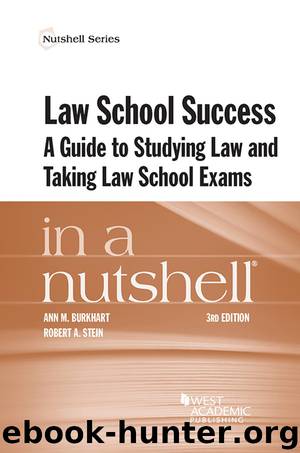Law School Success in a Nutshell by Ann Burkhart & Robert A Stein

Author:Ann Burkhart & Robert A Stein
Language: eng
Format: epub
ISBN: 9781683281856
Publisher: West Academic
Published: 2017-04-08T04:00:00+00:00
Identify the legal rule that governs that issue;
Analyze the facts in light of the legal rule; and
Reach a conclusion.
Just as you did when reading the problem, take notes as you think through and organize your answer. By doing so, you will remember to include each part of your answer and will follow your planned organization. The outline need not be extremely detailed. Rather, it should include just enough information to serve as a check list.
i.Identifying Issues
When reading the problem, you will have identified issues that potentially are raised by it. As you now think through the problem and your answer, ask yourself which of these issues must be resolved to answer the question. In other words, identify the 191
legally relevant issues. Although the facts in the problem may raise many issues, address only those that have a bearing on the specific question you have been asked. This process of identifying the legally relevant issues is the same one you have used in your classes and on your legal writing assignments. You are distinguishing the relevant facts and law from the irrelevant. Writing a brilliant discussion of an irrelevant issue will not increase your grade.
Assessing an issue’s relevance is inextricably linked with analyzing the question. For example, assume that the exam includes the following question:
Adams sold a parcel of land, Blackacre, to Baker and Chen, who are unmarried. The deed stated: “Adams hereby conveys Blackacre to Baker and Chen as joint owners.” Chen subsequently transferred his interest to Dale. What is the current state of title to Blackacre?
Recognizing that the deed language may have created either a joint tenancy or a tenancy in common, you might be tempted to address that issue. However, if you first analyze the entire problem, you will discover that the issue is irrelevant to answering the question. Whether a joint tenancy or tenancy in common was created, Chen had the legal power to transfer his interest to Dale, and Baker and Dale own Blackacre as tenants in common.
When writing your answer to this question, state that the deed language is ambiguous with respect to whether a joint tenancy or a tenancy in common was 192
created. A detailed analysis of that issue is unnecessary, however, because it does not affect the current state of title. Simply state that Chen could transfer his interest regardless of whether he was a joint tenant or a tenant in common and then analyze the state of title after the transfer. By thinking through the problem in this way before beginning to write an answer, you will avoid writing about an irrelevant issue.
No magic formula exists for knowing which issues to discuss. But, in case of doubt, include the issue. For example, if you think that a legal principle does not clearly apply to the situation described in the exam problem but that the policies underlying the principle would be served by applying it, discuss that issue. Similarly, if you are applying a rule that includes three elements, two of which are
Download
This site does not store any files on its server. We only index and link to content provided by other sites. Please contact the content providers to delete copyright contents if any and email us, we'll remove relevant links or contents immediately.
Working for Yourself by J.D. (Nolo) Stephen Fishman(1815)
Every Landlord's Legal Guide by Janet Portman & Stewart Marcia & Ralph Warner(1628)
Working for Yourself by Stephen Fishman J.D. (Nolo)(1477)
A Practical Guide to International Arbitration in London by Hilary Heilbron(1395)
Nolo's Essential Guide to Divorce by Emily Doskow(1379)
Plan Your Estate by Attorney Denis Clifford(1300)
Profit From Your Idea: How to Make Smart Licensing Deals by Attorney Richard Stim(1296)
Nolo's Encyclopedia of Everyday Law: Answers to Your Most Frequently Asked Legal Questions by Shae Irving & Nolo (Editor)(1296)
Introduction to the study and practice of law in a nutshell by Kenney F. Hegland(1286)
American Bar Association Guide to Wills and Estates by American Bar Association(1224)
How to Plan and Settle Estates by Edmund Fleming(1221)
Nolo's Encyclopedia of Everyday Law: Answers to Your Most Frequently Asked Legal Questions by Shae Irving; Nolo (Editor)(1213)
The Trademark Guide by Lee Wilson(1200)
American Bar Association Guide to Wills and Estates, Fourth Edition: An Interactive Guide to Preparing Your Wills, Estates, Trusts, and Taxes by American Bar Association(1189)
The Writer's Legal Guide by Tad Crawford(1169)
The Essential Executor's Handbook by David G. Hoffman(1123)
Later-in-Life Lawyers: Tips for the Non-Traditional Law Student by Cooper Charles(1087)
Limited Liability Companies For Dummies by Jennifer Reuting(1086)
9:41 by Iannuzzi John Nicholas;(1073)
